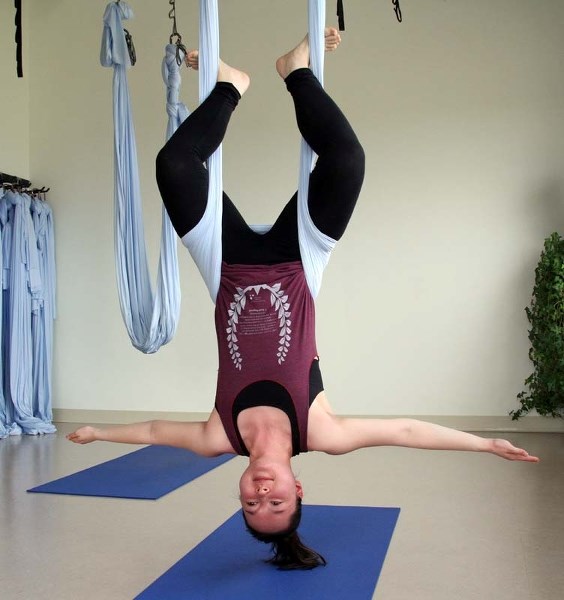My head is floating just inches above the floor as I hang like an aerial contortionist from a loop of fabric suspended from the ceiling.
“Now slide your hands down,” coaxes Lisa Babiuk, owner of Soul Fitness Mind Body Studios in Campbell Business Park.
She is telling me to let go of the nylon strung between my fists. I can’t let go; my hands are paralyzed.
Babiuk prods again, reassuring me that I will not fall out of the hammock – the only thing keeping me from a surefire concussion.
I take a deep breath and release my hands, spreading them out as gracefully as I can into inverted monkey pose. I feel free, weightless! I’m a kid again, hanging upside down on the playground jungle gym.
“Adults love it too, but the kids really, really love it,” says Babiuk. “They love to hang upside down and swing.”
This summer will mark the third year that Soul Fitness Mind Body Studios is running suspension yoga for adults, teens and children.
Also referred to as aerial yoga or anti-gravity yoga, suspension yoga has participants execute postures used in regular yoga classes – such as downward dog, warrior or tree pose – with the addition of an aerial silk hammock.
I grimace as I attempt triangle pose and the hammock swings back and forth, the hinges loudly creaking.
“We had to have the ceiling and the roof designed specifically to hold the loads of the hammocks, the people in the hammocks and the weight of the snow in the winter,” reassures Babiuk, adding that each component is designed to hold a minimum of 3,000 pounds.
“In other words, you’re safe,” she says.
Suspension yoga allows for a deeper stretch in yoga postures and releases pressure on your shoulders and wrists, says Babiuk. The constant movement of the fabric also adds resistance to further strengthen your upper body and your core.
“The fabric is hanging from the ceiling, it’s not fixed so it will move wherever it wants,” says Babiuk. “Part of the strengthening process in this practice is that you have to control the fabric. You can’t let it control you, or it will dump you right out.”
Babiuk instructs me to do some inversion postures (upside down ones). As a prop, the hammock supports your hips and allows you to invert without compressing your head or spine, she says.
Coming back to a neutral position – such as folding forward or lying back in the fabric like a hammock – is important after every inversion, explains Babiuk.
“What tends to happen when we’re going upside down, right side up, upside down and right side up is that sometimes people that are motion sensitive get vertigo.”
Upside-down postures are not recommended for people with glaucoma, high blood pressure, weak blood vessels or those who have experienced a stroke, since inversion significantly increases blood pressure.
Although pregnant women and people with spinal injuries are also not recommended to try inversion postures, suspension yoga is accessible and user-friendly, says Babiuk.
“If you’ve never done yoga, you can still come to this class. I think the hardest thing about this class is learning how to manipulate the fabric,” she says.
My one-hour session of suspension yoga was filled with a lot of creaks from the hammock hinges, but also a lot of laughter as I learned to stabilize myself and deepen the stretches.
My favourite posture was savasana (corpse pose) which involves wrapping yourself in the hammock like a cocoon. The best part is that you can have a quick catnap at the end of class without anyone noticing.




